Rev., December 8, 2016. Dedicated to BVM IC.
Note: this is the continuation of a previous post.https://rjamahoney.wordpress.com/2017/11/07/excavating-dream-and-sacred-space-in-the-decor-of-the-exterminating-angel-1962-part-1/
But then having set up that this is happening at the lattice level of sleep, and that a fixated picture is the instrument of the hypnosis conveyed by the lattice, Bunuel, in The Exterminating Angel (1962), takes the space even deeper into dream and magic by overlaying in it other spaces. The movie’s “to be continued” sequence at the end happens in church, and since the sheep end up running to the church, and all the guests, whom you would think would not want to see each other again, or at least for a very long time, they all go to church, one sniffs out a much more blatant allegory of parody against the static monotony of depleted church ceremony, a going through the motions
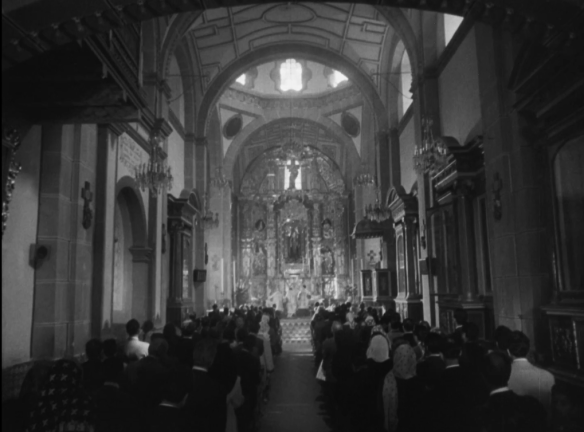 This is fine, to straighten the tie of things at the end, to allow the black-and-white thinkers or viewers to say, oh, it was an allegory against the catholic church, and its cultural paralysis, etc etc., but, in the actual heart of the movie, Bunuel works with religious thought as a possible contributor to the guests’ paralysis in a much more subtle way. As I see it, he sensed that he was working with an in-between dream state, and that the lattice was weighing things down in. So, then he had to think of devices to indicate in visual space the notion that the space is getting heavier and thicker, and they are becoming more and more paralyzed. He does this by them lying down, then divesting themselves, step by step, of civilized behavior, but in terms of the actual space of the parlor, he does this by driving them down deeper and deeper into the visual lore lying underneath the plague picture and the chandelier.
This is fine, to straighten the tie of things at the end, to allow the black-and-white thinkers or viewers to say, oh, it was an allegory against the catholic church, and its cultural paralysis, etc etc., but, in the actual heart of the movie, Bunuel works with religious thought as a possible contributor to the guests’ paralysis in a much more subtle way. As I see it, he sensed that he was working with an in-between dream state, and that the lattice was weighing things down in. So, then he had to think of devices to indicate in visual space the notion that the space is getting heavier and thicker, and they are becoming more and more paralyzed. He does this by them lying down, then divesting themselves, step by step, of civilized behavior, but in terms of the actual space of the parlor, he does this by driving them down deeper and deeper into the visual lore lying underneath the plague picture and the chandelier.
The first layer is religious imagery per se, of a Christian sort. The movie is called The Exterminating Angel, and that refers to the archangels that smote satan to hell, as part of the fall of the rebel angels from heaven. That we are watching the high and mighty of society, with all their airs and ironic elegancies, brought low, is certainly a theme, ripe for easy allegory. But spatially it is odd that on the far side of the parlor in which they are stuck, there are actually several panels with Renaissance style religious icons on them. It is St George Slaying the Dragon on the left, The Virgin Mary in the middle, and St Francis on the right.
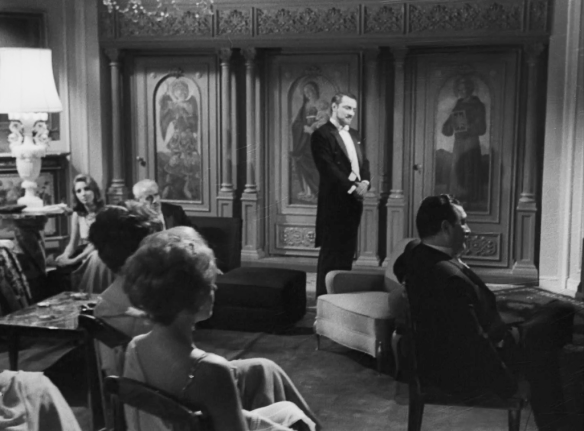 these two quite possibly have easy symbolic importance. But more important is what they preside over as spirits of the room, and of the guests’ captivity in it. St George comically presides over fraternal secrecy, which is so funny
these two quite possibly have easy symbolic importance. But more important is what they preside over as spirits of the room, and of the guests’ captivity in it. St George comically presides over fraternal secrecy, which is so funny
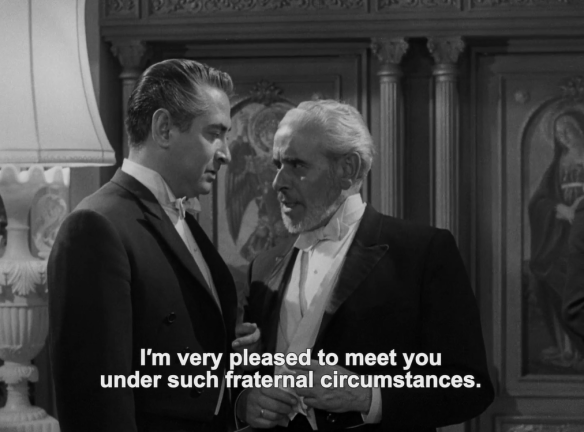 The Virgin seems to preside over the not-by-a-long-shot virgins in the gathering
The Virgin seems to preside over the not-by-a-long-shot virgins in the gathering
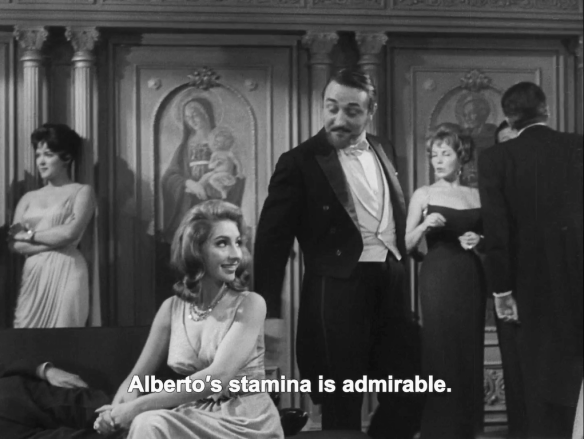 though even also to possibly lampoon the easy sluttishness of the upper class whore these days
though even also to possibly lampoon the easy sluttishness of the upper class whore these days
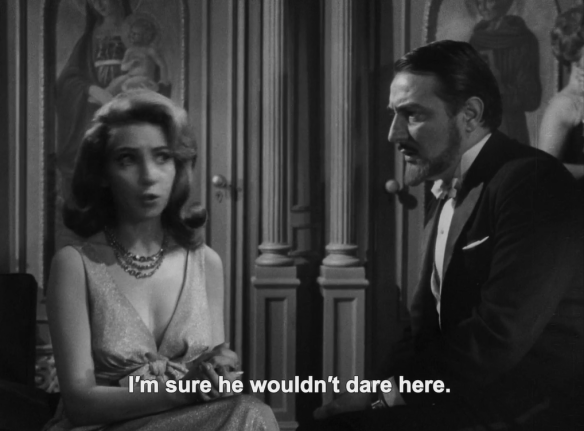 The Virgin Mary always seems to be contrasted with impulses of lust, even when after the men are disgusted with the women, who smell, and are not sexy anymore, it does seem to keep on coming up, at least on camera, here a bare back revving up the motor of lust again
The Virgin Mary always seems to be contrasted with impulses of lust, even when after the men are disgusted with the women, who smell, and are not sexy anymore, it does seem to keep on coming up, at least on camera, here a bare back revving up the motor of lust again
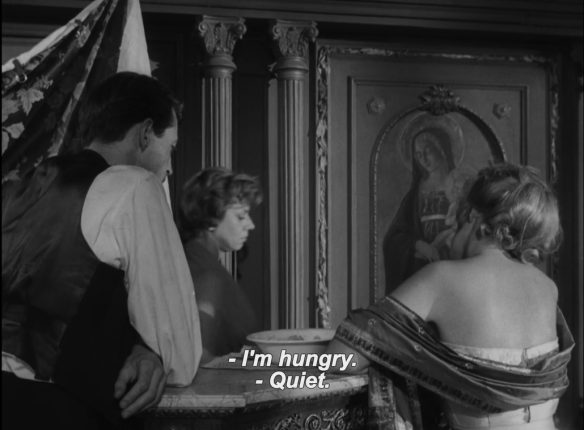 St Francis seems to preside over growing complaints of others infelicities, as they begin to drive each other crazy on an intimate level. This young man is complaining that if he sees the woman at the mirror brush her hair half way down again and not all the way down he will kill her
St Francis seems to preside over growing complaints of others infelicities, as they begin to drive each other crazy on an intimate level. This young man is complaining that if he sees the woman at the mirror brush her hair half way down again and not all the way down he will kill her
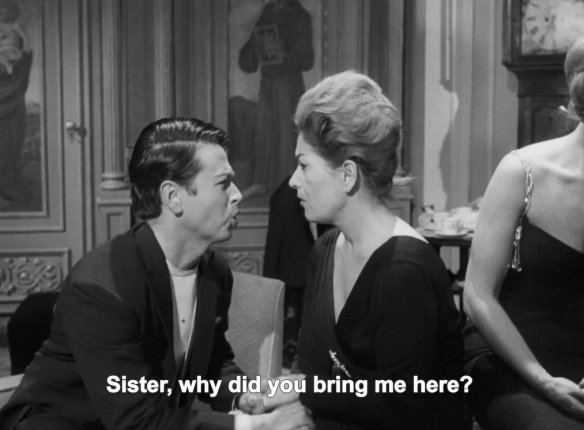 one couple finds that St George hides a closet so retreat to it to sleep together in some privacy, though I can hardly believe that they would have had full on sex within earshot of all the other guests
one couple finds that St George hides a closet so retreat to it to sleep together in some privacy, though I can hardly believe that they would have had full on sex within earshot of all the other guests
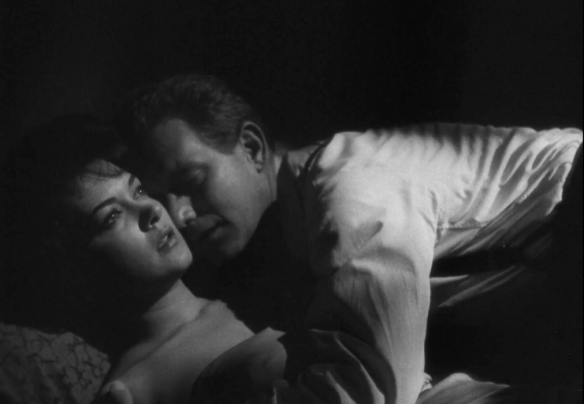 whenever another man tries to get up the gumption to make still another effort to get out, and make this end, it seems that St George is always watching over him
whenever another man tries to get up the gumption to make still another effort to get out, and make this end, it seems that St George is always watching over him
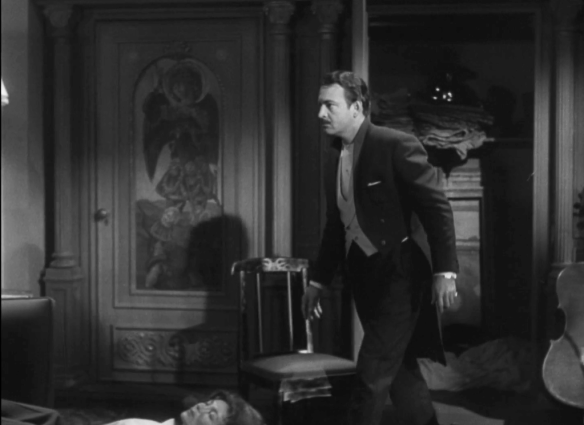 in the other St Francis closet, the man who dies is placed, and, rather gruesomely, a few days later they have to try to plug up the space between door and wall on the hinge because his dead body is beginning to stink
in the other St Francis closet, the man who dies is placed, and, rather gruesomely, a few days later they have to try to plug up the space between door and wall on the hinge because his dead body is beginning to stink
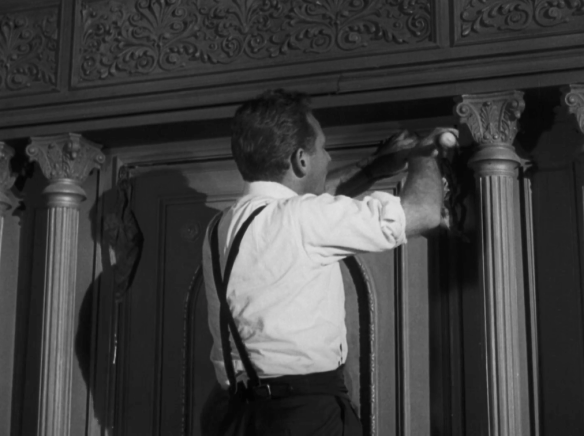 it is possible that the presence of the body behind door number three, and the presence of a couple having sex behind door number one, agitated the imaginations of those who did not stake a claim to those spaces, because when the one woman has her vision of a hand crawling toward her at night, it starts with the three saints as well as the tall lamp serving as alibi formations in order to incite a bodily visualizaiton
it is possible that the presence of the body behind door number three, and the presence of a couple having sex behind door number one, agitated the imaginations of those who did not stake a claim to those spaces, because when the one woman has her vision of a hand crawling toward her at night, it starts with the three saints as well as the tall lamp serving as alibi formations in order to incite a bodily visualizaiton
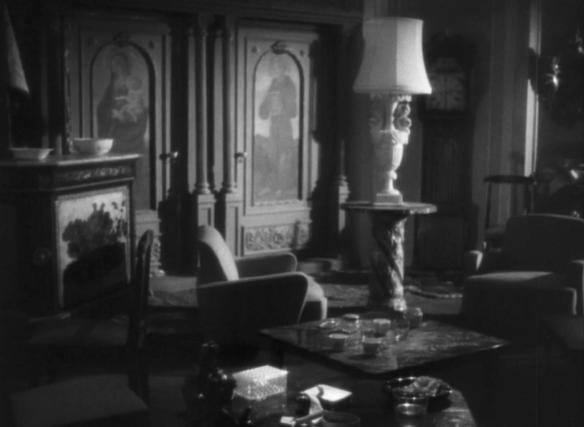 and out of the combination of the thoughts of people behind the pictures, animating the picture from their new position of prototypes, dead and having sex, then fed through the sarcophagal materiality of the lamp, she hallucinates onto the carpet a hand coming toward her
and out of the combination of the thoughts of people behind the pictures, animating the picture from their new position of prototypes, dead and having sex, then fed through the sarcophagal materiality of the lamp, she hallucinates onto the carpet a hand coming toward her
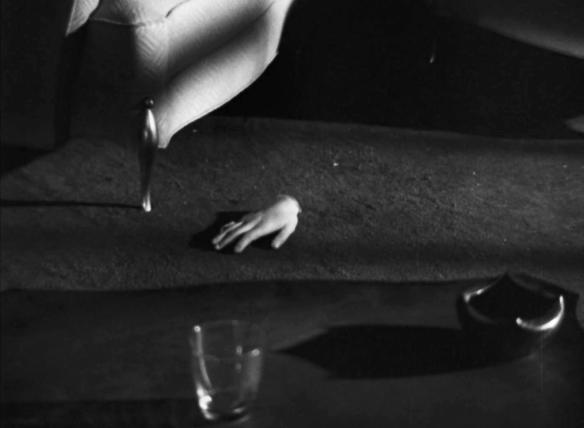 they do not play a major part, then, but this whole flank of three doors, with images of the saints on them, renders the room as a kind of chapel. And the closets then serve as a kind of confessional where the darkest things not to be thought of in the parlor as a whole go, sex and death. The way they preside then means that in addition to a hypnotized space, and a lattice dream space, this is a space that, being weighed down and pushed into dream, has regressed from a secular party space to a nighttime religious space. It reframes the space as a ritual, sacred space, and what they do as ritual acts, in a dream.
they do not play a major part, then, but this whole flank of three doors, with images of the saints on them, renders the room as a kind of chapel. And the closets then serve as a kind of confessional where the darkest things not to be thought of in the parlor as a whole go, sex and death. The way they preside then means that in addition to a hypnotized space, and a lattice dream space, this is a space that, being weighed down and pushed into dream, has regressed from a secular party space to a nighttime religious space. It reframes the space as a ritual, sacred space, and what they do as ritual acts, in a dream.
There are two additional echoes on the religious aspect of things, with regard to Christianity, and one is verbal, the other spatial. On the verbal level, one woman, as many will do when in duress, reverts to religion, and in the middle of the night begins to cut deals with the Virgin (so possibly praying in front of the central panel), if you get me out of here, I will make a pilgrimage to Lourdes, in thanks.
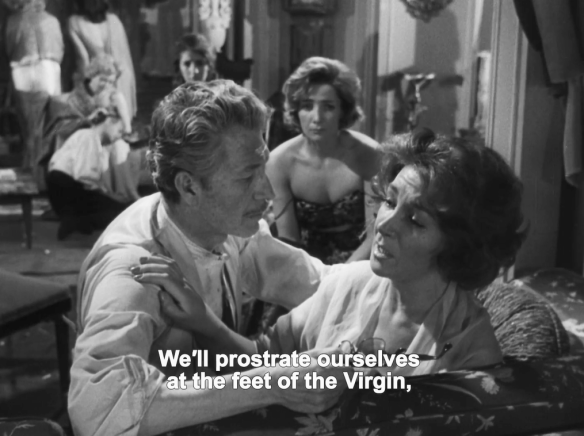 I suppose in so-secular 1962 it was blackly comic to find that underneath all their jewelry and hairdos and revealing dresses and naked skin, Spanish women were still devoted to the Virgin, not so much today, but it is something. She then takes it to another level, trying to enlist the others, and also revealing that her cult behavior is very much compromised or enriched by the conveniences of modern life
I suppose in so-secular 1962 it was blackly comic to find that underneath all their jewelry and hairdos and revealing dresses and naked skin, Spanish women were still devoted to the Virgin, not so much today, but it is something. She then takes it to another level, trying to enlist the others, and also revealing that her cult behavior is very much compromised or enriched by the conveniences of modern life
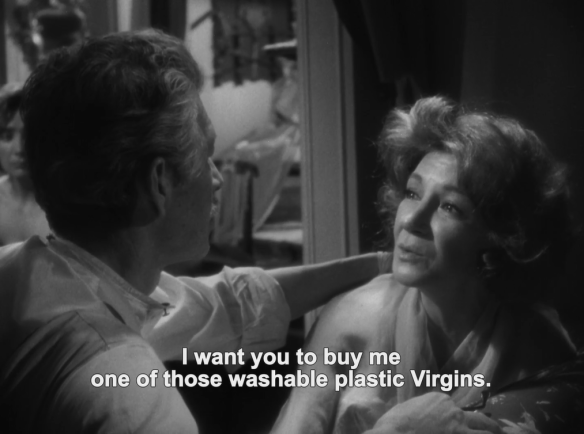 and one might also call the movie Washable Plastic Virgins, it was a laugh out loud moment, but for its absurdity, not its comedy. She might also have got the idea from the second religious vibe that comes up. They need water, and, conveniently, a water pipe runs in the wall behind the parlor, so by whacking at the wall, they manage to break a pipe and have water (it is not entirely clear how this would work). Just before, they were running out of water, which is serious, and when the butler concedes to being out, an enterprising gent suggests she drinks the flower vase water, it smells, but it should be ok, she refuses
and one might also call the movie Washable Plastic Virgins, it was a laugh out loud moment, but for its absurdity, not its comedy. She might also have got the idea from the second religious vibe that comes up. They need water, and, conveniently, a water pipe runs in the wall behind the parlor, so by whacking at the wall, they manage to break a pipe and have water (it is not entirely clear how this would work). Just before, they were running out of water, which is serious, and when the butler concedes to being out, an enterprising gent suggests she drinks the flower vase water, it smells, but it should be ok, she refuses
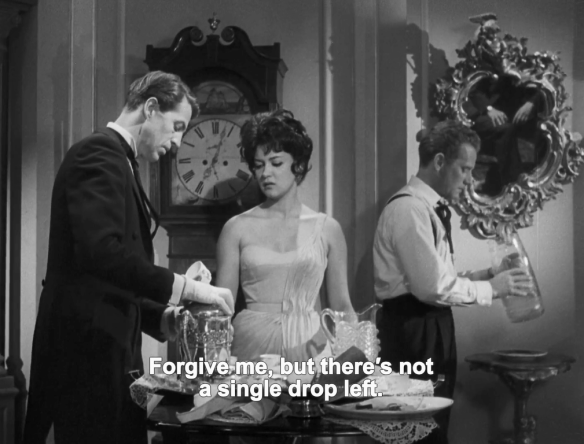 so comes the whacking
so comes the whacking
 the whacking away is also an easy symbol of the regress of civilization from the fancy veneer to the rough undercoat, but it is more than that since what they get is a spring, not a faucet, and so they all rush to it like it is, in fact, a spring at Lourdes, soaking up the holy water as they might as if at a religious shrine site
the whacking away is also an easy symbol of the regress of civilization from the fancy veneer to the rough undercoat, but it is more than that since what they get is a spring, not a faucet, and so they all rush to it like it is, in fact, a spring at Lourdes, soaking up the holy water as they might as if at a religious shrine site
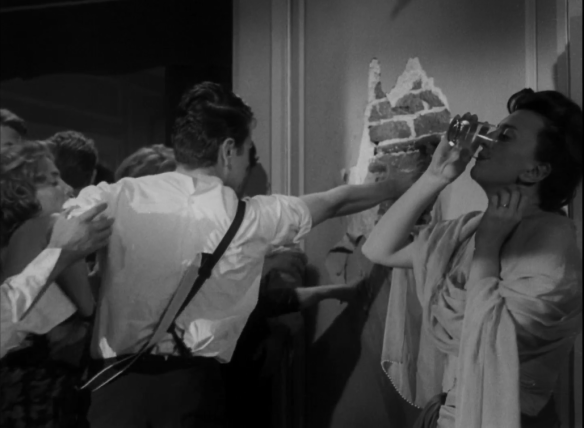 it is such a richly comic scene, deep in symbolism. All the sophisticated seculars, reverting to primitive cult. The way they wait in line, the way the water comes out, and they are devotedly praying for every drop
it is such a richly comic scene, deep in symbolism. All the sophisticated seculars, reverting to primitive cult. The way they wait in line, the way the water comes out, and they are devotedly praying for every drop
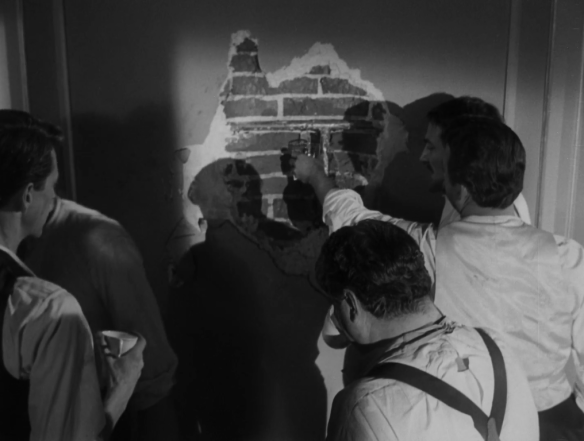 and while it eventually recedes from notice as simply another element of their new routine, with the butler apparently managing the site, for a brief moment of discovery it was as if a primitive country shrine site exuding miracle water descended into the room, causing the Virgin Mary to come alive, an the woman to by not so free association, feel free to talk about her Lourdesian desires. As a result, though the one happens before the other, these events make a votive space of the space. That is, they have dropped down to praying, and praying hard for help, and offering themselves up for it if a miracle occurs, and then it does. Thus, in addition to the hypnotic picture, the lattice chandelier, and the saints icons, that is, the spell space, the lattice dream space, and the chapel-confessional space, we now have a shrine-votive space in the room. It is becoming a regular microcosm of the Spanish mind.
and while it eventually recedes from notice as simply another element of their new routine, with the butler apparently managing the site, for a brief moment of discovery it was as if a primitive country shrine site exuding miracle water descended into the room, causing the Virgin Mary to come alive, an the woman to by not so free association, feel free to talk about her Lourdesian desires. As a result, though the one happens before the other, these events make a votive space of the space. That is, they have dropped down to praying, and praying hard for help, and offering themselves up for it if a miracle occurs, and then it does. Thus, in addition to the hypnotic picture, the lattice chandelier, and the saints icons, that is, the spell space, the lattice dream space, and the chapel-confessional space, we now have a shrine-votive space in the room. It is becoming a regular microcosm of the Spanish mind.
And, then, there is more. Though it is likely that the woman who has the hallucination of the crawling hand, the only true horror movie trope in the movie, was incited to that state by the saint’s figures on the doors on that side of the room, and the sarcophagal lamp there, once it gets up close, and she sees it, and engages it in the state of the hallucination, the dynamics of oversight changes. She is now presided over by another figure
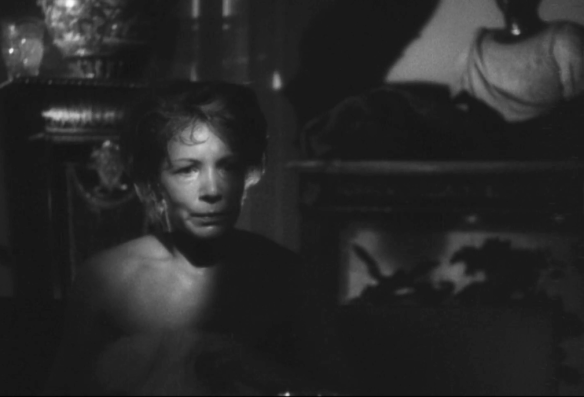 and when she sees the hand come up on the table, if I recall, and move the handkerchief, so she is deeply in this, the figure is still there, presiding
and when she sees the hand come up on the table, if I recall, and move the handkerchief, so she is deeply in this, the figure is still there, presiding
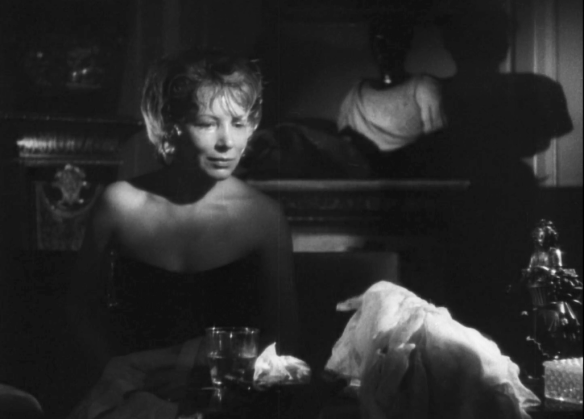 this hallucination is so intense that she is prompted to act, and stabs at it, terrifying one sleeping nearby, worried that she was stabbing her
this hallucination is so intense that she is prompted to act, and stabs at it, terrifying one sleeping nearby, worried that she was stabbing her
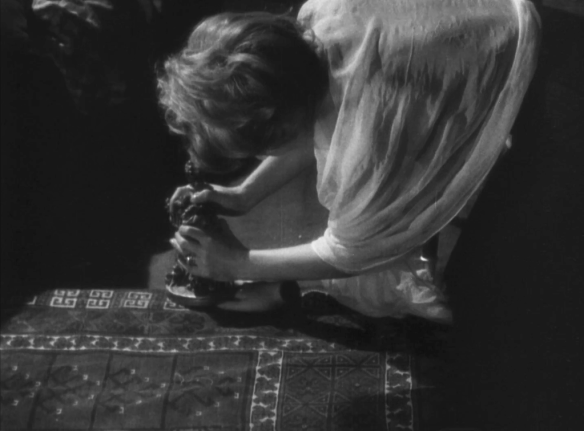 and then she snaps out of it, but is stunned that in the middle of the night her nerves and insomnia had pushed her to a waking nightmare, and still he presides
and then she snaps out of it, but is stunned that in the middle of the night her nerves and insomnia had pushed her to a waking nightmare, and still he presides
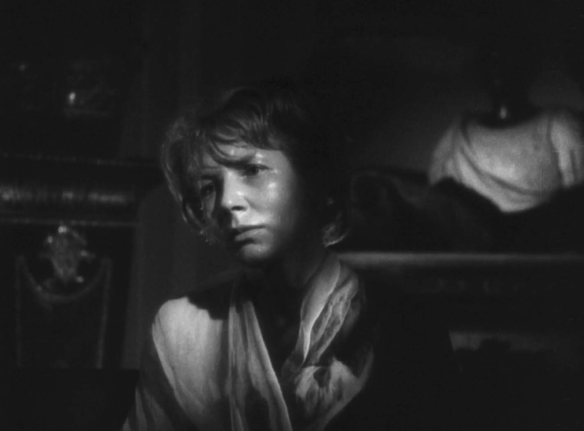 Who this “he” is is the other question, but he too is a familiar presence in the homes of the aristocrats, particularly in Italian and Spanish movies of the times. He is a Roman bust, presumably Augustus, or the like, and he is one of those multicolored busts that has a black face, not to indicate he is black, but to symbolize his power. He shows up a lot, in the parlor, indeed, he is almost as strong a presence as the saints and the storm picture. He appears to sit on a settee to the right of a standing plants to the right of the alcove in which the storm painting is held, and, then, on the other side, to the left of where the pipe shrine to water is made
Who this “he” is is the other question, but he too is a familiar presence in the homes of the aristocrats, particularly in Italian and Spanish movies of the times. He is a Roman bust, presumably Augustus, or the like, and he is one of those multicolored busts that has a black face, not to indicate he is black, but to symbolize his power. He shows up a lot, in the parlor, indeed, he is almost as strong a presence as the saints and the storm picture. He appears to sit on a settee to the right of a standing plants to the right of the alcove in which the storm painting is held, and, then, on the other side, to the left of where the pipe shrine to water is made
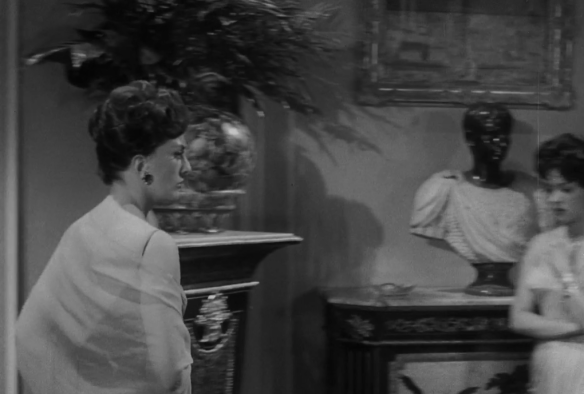 he keeps looking over shoulders at the ladies, or evoking the fatigue of the men faltering in the background
he keeps looking over shoulders at the ladies, or evoking the fatigue of the men faltering in the background
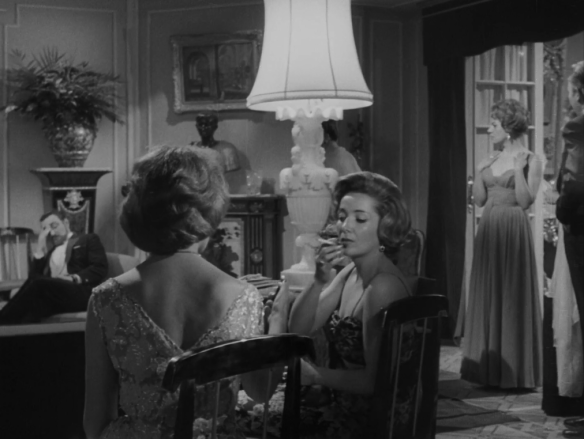 he also profiles men in their man of the house strength, and this would be the tradtional daytime reading of the thing (I have written of the tendency of Roman busts in horror to represent the manipulations of the man of the house in the context of Peter Cushing’s Compulsion and Boris Karloff’s Cauldron of Blood, but it is a very common theme, even outside of horror, in daylight, this is a power statement by the man of the house, I am in charge)
he also profiles men in their man of the house strength, and this would be the tradtional daytime reading of the thing (I have written of the tendency of Roman busts in horror to represent the manipulations of the man of the house in the context of Peter Cushing’s Compulsion and Boris Karloff’s Cauldron of Blood, but it is a very common theme, even outside of horror, in daylight, this is a power statement by the man of the house, I am in charge)
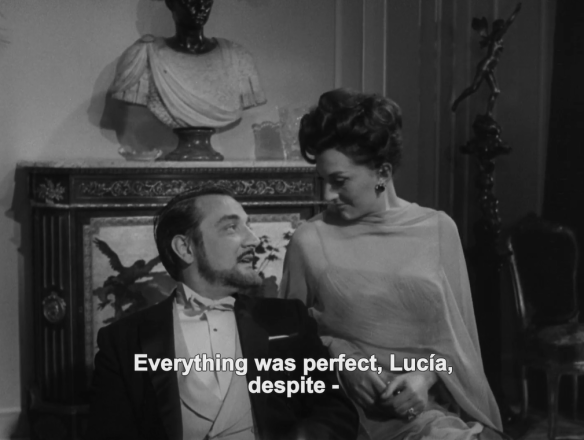 but as the men begin to see their power sloughed off, accomodating to the situation, the bust is increasingly pictured with a strange, generic classical picture over it
but as the men begin to see their power sloughed off, accomodating to the situation, the bust is increasingly pictured with a strange, generic classical picture over it
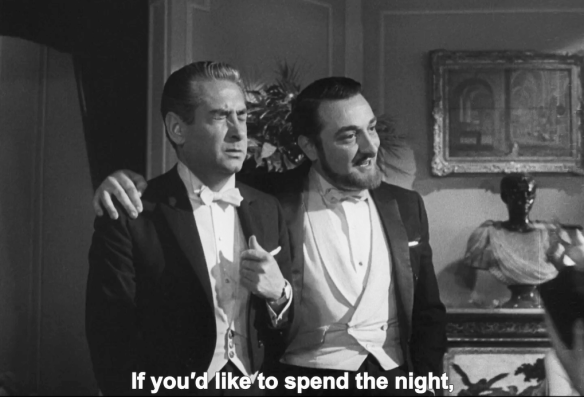 the picture is in the Piranesi mode, but in fact seems to be of a church interior
the picture is in the Piranesi mode, but in fact seems to be of a church interior
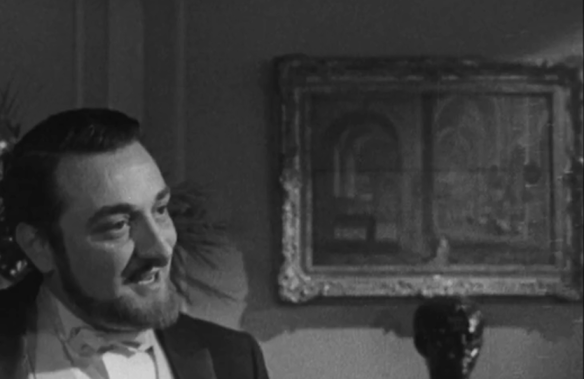 and if the bust by itself in the light represented the man of the house in his power, in the dark, halo’d by the vista of an infinite regress in classical space, he becomes, in my view, Morpheus himself, god of sleep, and of bad dreams in sleep
and if the bust by itself in the light represented the man of the house in his power, in the dark, halo’d by the vista of an infinite regress in classical space, he becomes, in my view, Morpheus himself, god of sleep, and of bad dreams in sleep
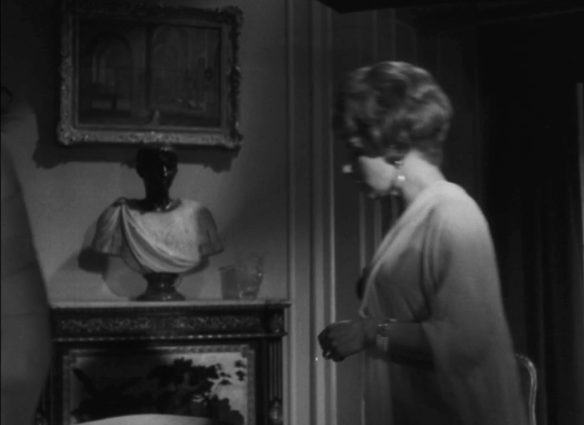 it is also to be noted that he exists very close to the magic door, from which none of them can leave, on the dining room side. For that, he is also a kind of herm, but also possibly has something to do with the restricting lock on the room
it is also to be noted that he exists very close to the magic door, from which none of them can leave, on the dining room side. For that, he is also a kind of herm, but also possibly has something to do with the restricting lock on the room
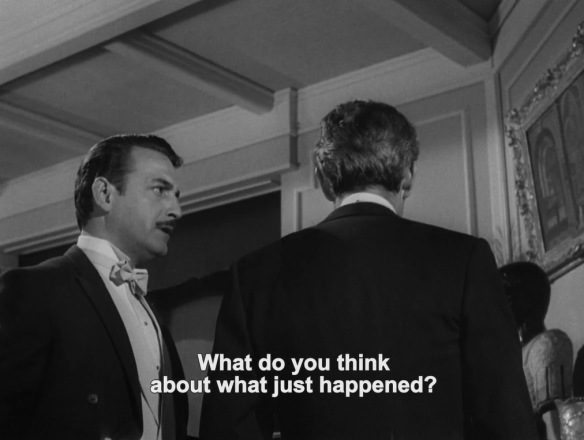 later on a man crawls on the floor in front of the classical scene on the front of the piece of furniture that the bust sits on
later on a man crawls on the floor in front of the classical scene on the front of the piece of furniture that the bust sits on
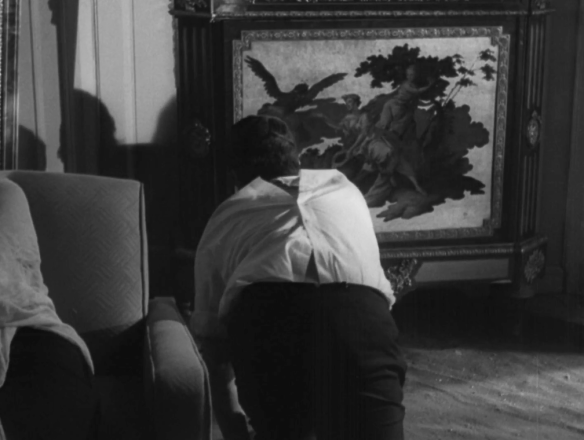 and he presides, I believe, over the finding of the box of morphine, which is used by some to get them through the ordeal
and he presides, I believe, over the finding of the box of morphine, which is used by some to get them through the ordeal
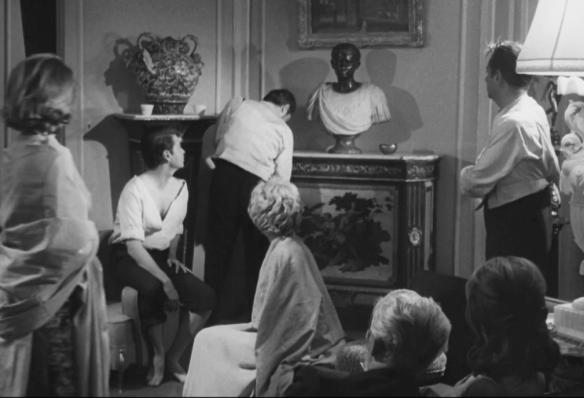 and then he presides again as Augustus when they begin to wake up from it all
and then he presides again as Augustus when they begin to wake up from it all
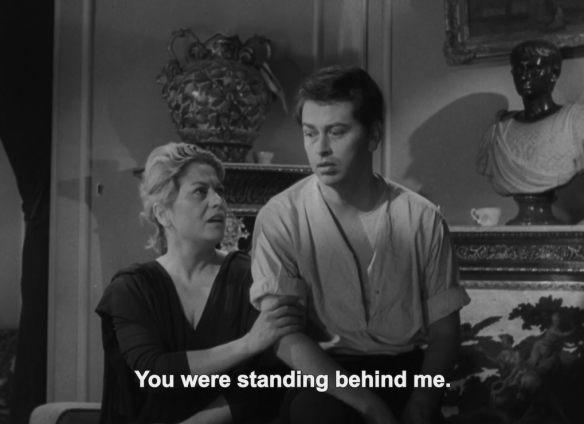 who is he? from the above image he is easily recognizable as Augustus, so represents male powered civilization in the house, but in the dark, he is effaced, he becomes enhaloed by an infinite recess in space, and for that I think he takes on the role of Morpheus, and in that he represents a deepening of the pressure in the room, the lattice now pushing civilization down from contemporary sophisticated secular, to medievel Christian, and then to genius-lares based Roman animism, then the sacred home is invaded by hallucinations and dreams. In this, he makes of his area of the room the atrium, but then the wormhole of the room, whooshing it down to a deeper state of dream. Morpheus was actually known as a god who would inhabit a dream and impersonate a figure in a dream to speak through that figure to you in a dream, in a prophetic way, he was an intrusion of the divine into sleep, and then pushed down all the way to the bottom of dream, resulting in a waking nightmare, as the one woman had. For that, he creates the heaviest part of the parlor in the movie, even though as a trope he is not made that much use of. As I map it out then, and making no claim that Bunuel ever conceptualized this except intuitively, the parlor is turned by their predicament into a magic space, inside a lattice dream space, the pressure of which pushes a contemporary secular space down into a medieval ritual space, which subdivides then into a confessional, a burial crypt and water miracle shrine, and then it breaks down into a Roman lares space, where the presiding god leads you down the wormhole to a waking nightmare state where you can see, in fact, hands crawl
who is he? from the above image he is easily recognizable as Augustus, so represents male powered civilization in the house, but in the dark, he is effaced, he becomes enhaloed by an infinite recess in space, and for that I think he takes on the role of Morpheus, and in that he represents a deepening of the pressure in the room, the lattice now pushing civilization down from contemporary sophisticated secular, to medievel Christian, and then to genius-lares based Roman animism, then the sacred home is invaded by hallucinations and dreams. In this, he makes of his area of the room the atrium, but then the wormhole of the room, whooshing it down to a deeper state of dream. Morpheus was actually known as a god who would inhabit a dream and impersonate a figure in a dream to speak through that figure to you in a dream, in a prophetic way, he was an intrusion of the divine into sleep, and then pushed down all the way to the bottom of dream, resulting in a waking nightmare, as the one woman had. For that, he creates the heaviest part of the parlor in the movie, even though as a trope he is not made that much use of. As I map it out then, and making no claim that Bunuel ever conceptualized this except intuitively, the parlor is turned by their predicament into a magic space, inside a lattice dream space, the pressure of which pushes a contemporary secular space down into a medieval ritual space, which subdivides then into a confessional, a burial crypt and water miracle shrine, and then it breaks down into a Roman lares space, where the presiding god leads you down the wormhole to a waking nightmare state where you can see, in fact, hands crawl
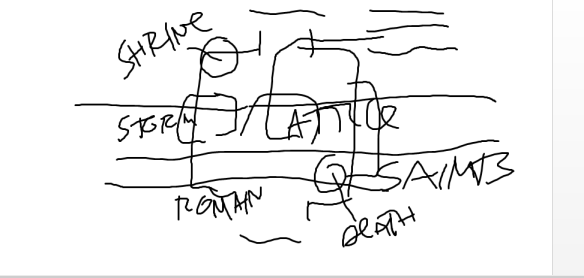 That is the aerial view, this is the vertical view, lattice at stage three, pressing down the whoosh to deep dream
That is the aerial view, this is the vertical view, lattice at stage three, pressing down the whoosh to deep dream
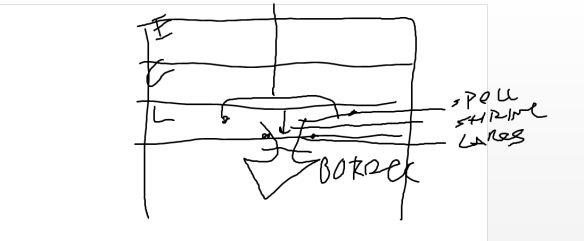 in all cases, when an eccentric setting is carved out of the generic space of the room, to become a stage for some sort of intense interaction, agency is activated. In the storm space, the agency is lethargy, loss of power; in the lattice space, fear; in the shrine spaces, offerings and guardianships; in the lares space, cult hauntings. In each corner of the room, by the occupation of these people in this predicament, each is brought to life as a place where magic happens, and agency chugs to life, cutting through the grid of rationalization by which we evade and deplete life itself.
in all cases, when an eccentric setting is carved out of the generic space of the room, to become a stage for some sort of intense interaction, agency is activated. In the storm space, the agency is lethargy, loss of power; in the lattice space, fear; in the shrine spaces, offerings and guardianships; in the lares space, cult hauntings. In each corner of the room, by the occupation of these people in this predicament, each is brought to life as a place where magic happens, and agency chugs to life, cutting through the grid of rationalization by which we evade and deplete life itself.
And in order to complete this deconstruction of the space into a dream space, the space will require boundaries. They come, of course, in the two sides of the room, no doors, which they cannot get out of. On the dining room, it is a barrier, the host does not understand why he cannot cross
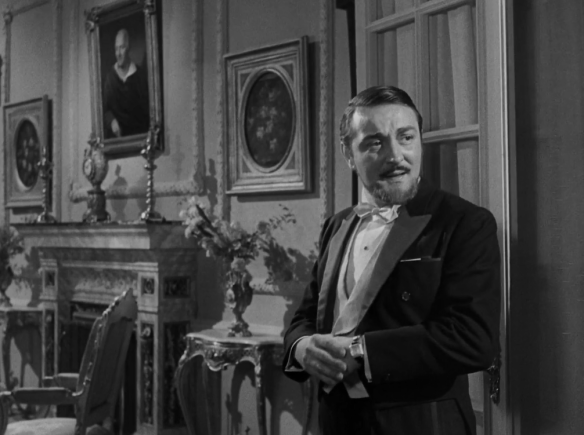 the butler does not know why he cannot cross
the butler does not know why he cannot cross
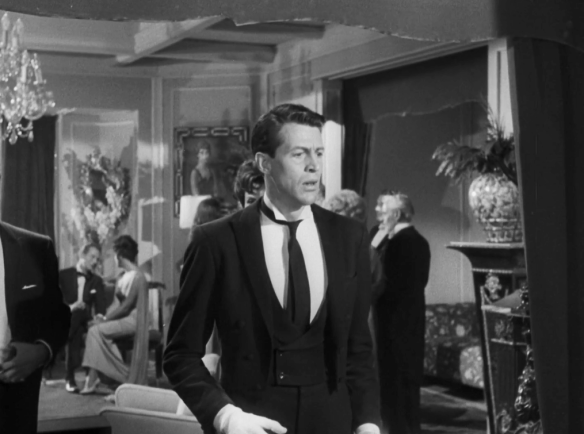 for a time he is mystified, but then later he realizes he can toss things across, never to be able to get to them, it is like an away space, a garbage zone, a dump, it does exist except as a place away from where they are, over the border, inadmissible
for a time he is mystified, but then later he realizes he can toss things across, never to be able to get to them, it is like an away space, a garbage zone, a dump, it does exist except as a place away from where they are, over the border, inadmissible
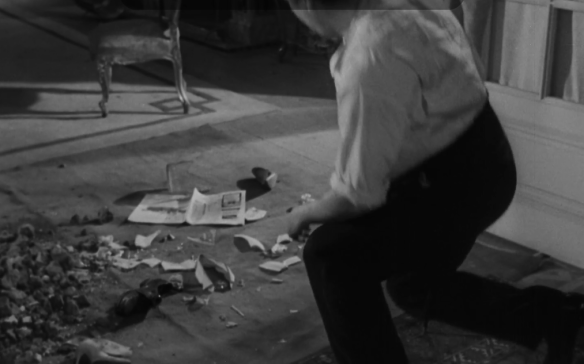 even more fun is on the other side, where there is a dark room
even more fun is on the other side, where there is a dark room
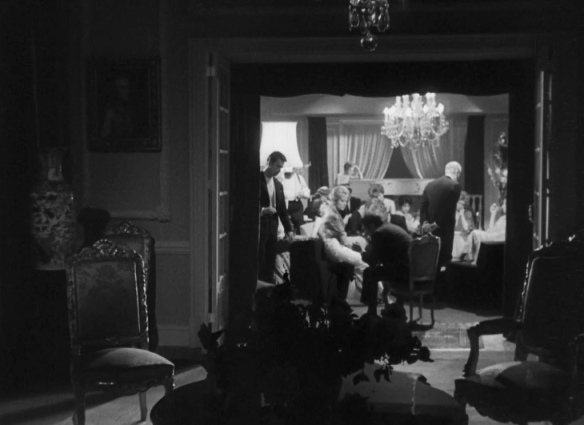 and that is the frontier as it were of their new world, the most primitive place, even below Rome, where they set the fire, and cook the sheep, and toss the refuse into the garbage pit of what a week before was the fancy adjacent parlor
and that is the frontier as it were of their new world, the most primitive place, even below Rome, where they set the fire, and cook the sheep, and toss the refuse into the garbage pit of what a week before was the fancy adjacent parlor
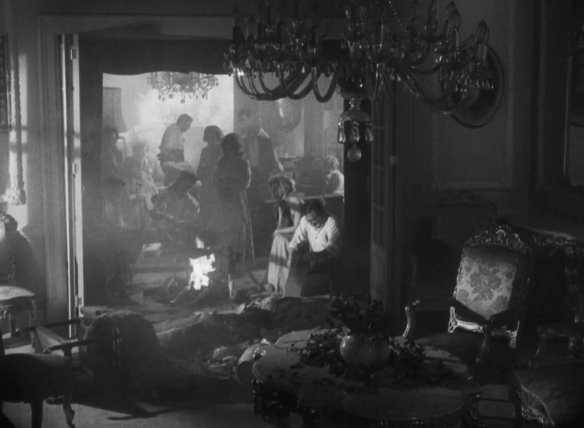 this is the most extreme level of dream state because it most closely aligns with child’s play in parcouring domestic space. It has been a long time since I played in such space for real, but I was an adult visitor in 2013 when my niece and nephew made tent forts between the furniture in the upper room, and saw again how by that simple rearrangement magic space can become activated as mine versus yours, ours versus theirs, sacred versus profane, and it is along the borders that one patrols, and stands guards at, that one worries and wonders, it is there too, as indicated by research about Greek disposal of statues at sea, that one drops things into an away space which one presumes means you will never hear from them again, they are gone. All of these elements come to play here, at the absolute level of primitiveness, below even the Roman dream stage, this is the stage at which we are in deep REM dream stage
this is the most extreme level of dream state because it most closely aligns with child’s play in parcouring domestic space. It has been a long time since I played in such space for real, but I was an adult visitor in 2013 when my niece and nephew made tent forts between the furniture in the upper room, and saw again how by that simple rearrangement magic space can become activated as mine versus yours, ours versus theirs, sacred versus profane, and it is along the borders that one patrols, and stands guards at, that one worries and wonders, it is there too, as indicated by research about Greek disposal of statues at sea, that one drops things into an away space which one presumes means you will never hear from them again, they are gone. All of these elements come to play here, at the absolute level of primitiveness, below even the Roman dream stage, this is the stage at which we are in deep REM dream stage
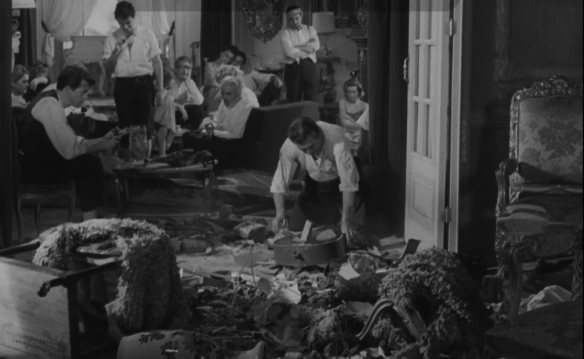 For all this, then, it is clear that The Exterminating Angel can be seen as a kind of transposed surreal horror movie. This is because like in any haunted house, the space has to be made to come alive to host a haunting, and that happens by various devices of hypnagogy whereby waking consciousness is replaced by dream consciousness, and then the house finds its particular level which it then chooses to do its haunting on, with this or that mechanism. In this outing, Bunuel took the world of high society elegance by way of a plague-storm picture into a state of hypnosis, then he cast it into a lattice stage dream space, where what weighed down the guests was their bodies and their physical life. The weight of the lattice, in that phase, inhabiting that phase, then weighed down the secular space to reveal both in and behind the saint’s panels, and then at the shrine site of the water pipe, with mention of Lourdes, a religious medieval layer of dream space. Then, below that even, deep hallucination was ushered in when a daytime Augustus, representing the man of the house, in the dark morphed into Morpheus, to drag everyone down to a deeper lares-level haunted-genius Roman dream state. Finally, at the borders, pure dream was arrived at, and all pretense of civilization was gone. All of this elaborate layering, orchestrating by the properties, exuding influence into the room physically around them, but optically within shot, makes of the parlor in which these people were stuck one of the most delirously symbolic dream spaces in the movies. And it was all done by the simple manipulation of properties as any genre horror movie director might do, except—Bunuel did it all in a truly inspired way.
For all this, then, it is clear that The Exterminating Angel can be seen as a kind of transposed surreal horror movie. This is because like in any haunted house, the space has to be made to come alive to host a haunting, and that happens by various devices of hypnagogy whereby waking consciousness is replaced by dream consciousness, and then the house finds its particular level which it then chooses to do its haunting on, with this or that mechanism. In this outing, Bunuel took the world of high society elegance by way of a plague-storm picture into a state of hypnosis, then he cast it into a lattice stage dream space, where what weighed down the guests was their bodies and their physical life. The weight of the lattice, in that phase, inhabiting that phase, then weighed down the secular space to reveal both in and behind the saint’s panels, and then at the shrine site of the water pipe, with mention of Lourdes, a religious medieval layer of dream space. Then, below that even, deep hallucination was ushered in when a daytime Augustus, representing the man of the house, in the dark morphed into Morpheus, to drag everyone down to a deeper lares-level haunted-genius Roman dream state. Finally, at the borders, pure dream was arrived at, and all pretense of civilization was gone. All of this elaborate layering, orchestrating by the properties, exuding influence into the room physically around them, but optically within shot, makes of the parlor in which these people were stuck one of the most delirously symbolic dream spaces in the movies. And it was all done by the simple manipulation of properties as any genre horror movie director might do, except—Bunuel did it all in a truly inspired way.